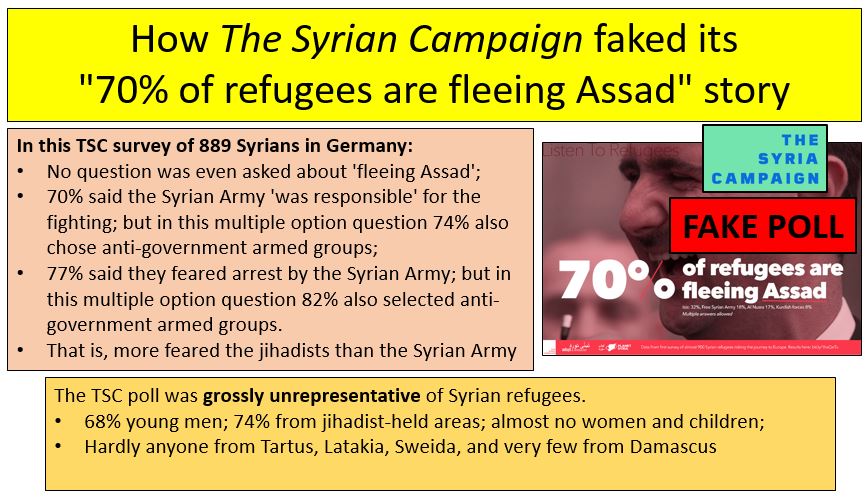How “The Syrian Campaign” Faked Its “70% Fleeing Assad” Refugee Poll

As one might expect, during a war, misunderstandings are often driven by interested parties. In the case of Syrian refugees in Europe a US based organisation called ‘The Syria Campaign’ has helped drive some of these, including a claim that most of the refugees are ‘Fleeing Assad’. ‘The Syria Campaign’ is a Wall Street Public Relations creation and one of several interlocked, US-based groups (Avaaz, Purpose, the White Helmets) which have campaigned for a Libyan-style ‘no fly zone’ in Syria. That is, they work for NATO intervention on the side of the jihadist groups (see Sterling 2015). In any case, a careful look at the evidence allows us to see through this ‘refugees fleeing Assad’ scam.
The Syria Campaign (2015) commissioned a poll in Germany which was apparently carried out by German academic Heiko Giebler. In it, 889 Syrian refugees were said to have been interviewed in Berlin, Hanover, Bremen, Leipzig and Eisenhüttenstadt. Candidates ‘were approached on entering or leaving registration centers’. However the survey does not specify how sampling choices were made (TSC 2015). This is important because sampling error can easily undermine the representative nature of a poll. Indeed if there is no sampling error, as in this case, there is no way to assert to what extent the survey represents a broader population. The results are then almost useless, except as anecdotes.
The poll cover note, headline and graphics highlight a claim that ‘70% of refugees are fleeing Assad’. To begin with, this is a false characterisation of the actual survey (TSC 2015). It had no question at all about fleeing Assad, nor anyone else. It did have questions on whom the respondents blamed for the violence and of whom they were afraid. Of the 30 survey questions the three relevant ones seem to be number 9 (‘Who was responsible for the fighting?), number 14 (‘Who did you fear getting arrested or kidnapped by?’), and number 18 (‘What was the main reason for you to leave Syria?’). Observe that question 18 does not specify any particular threat while in questions 9 and 14 (as is made clear in the survey report) there were multiple options, so results in both cases tally to much more than 100.

The Syrian Campaign’s cover note, headline and graphics have drawn, very loosely, on some combination of those three questions. In response to question 18 69% said that ‘the main reason’ for leaving Syria was an ‘imminent threat’ to life, but without an identified source of that threat. In Question 9, 70% identified ‘Syrian Army and allied groups’ as ‘responsible for the fighting’. However as this was a multiple option question we also see that 82% have identified other armed groups (ISIS, al Nusra, FSA, YPG, other rebels). If we remove the Kurdish YPG, which has generally fought in coordination with the Syrian Army, the total is 74% anti-government armed groups. Question 14 shares the ‘multiple option’ structure of Question 9. Here 77% said they feared ‘getting arrested or kidnapped by’ the ‘Syrian Army and its allied groups’. However the combined total of anti-government groups is 82% and, if we add the YPG, 90%. The answers to both questions suggest these respondents feared the anti-government armed groups slightly more than they feared the Syrian Army. Most likely, many feared getting caught in the crossfire.
So, even before we examine the representative validity of the poll, there is no basis in any of those three questions – or anywhere else in the poll – for saying that ‘70% of refugees are fleeing Assad’. To the contrary, the poll shows that more are fleeing anti-government, jihadist armed groups. This contradicts The Syrian Campaign’s quite dishonest headline, underlined by its lead in: ‘the results are crystal clear’. A Deutsche Welle report faithfully noted: ‘Survey leaves no doubt: Syrians are fleeing Assad’ (Fuchs 2015). Apparently this reporter did not read the survey.
Further internal analysis, combined with UNHCR (2016) data for 2015 on the wider Syrian refugee population, shows The Syrian Campaign’s survey to have been quite unrepresentative, and therefore no basis for claims about the wider Syrian refugee population. As Table 2 shows, the respondents in Germany had massive over-representation from men and young men. Put together we see a 1.76 over-representation of males and a 2.25 over-representation of people between 15 and 55 (UNHCR: 18-59; TSC: 15-55). Women and children barely exist in the TSC poll. The poll also shows that 51% came alone to Europe, 61% have no children and that 68% (0.78 x 0.88) are young men between 15 and 35 years old.
| Table: Syria refugee population profile, 2015 | ||
|
UNHCR, Syrian refugee registration (4.8 million) |
TSC survey, Germany, October (889) |
|
| Male |
50% |
88% (1.76 over-rep) |
| 15-35 years old |
n.a. |
78% |
| 15-55 / 18-59 years old |
44% |
99% (2.25 over-rep) |
Other data within the poll indicates that 74% were from areas held by anti-government armed groups, as they reported government shelling. There is no credible evidence that suggests the Syrian Army shells areas which do not contain armed anti-government groups. That is reinforced by Question 1 on area of origin, which shows hardly any respondents (just 19 people) from Tartus, Latakia and Sweida, areas which in 2015 had a combined population (swollen, from internal refugees) of at least 5 million. Respondents from Damascus (170 or 19%) are also seriously under-represented. Damascus in 2015 held over 7 million, or one-third of Syria’s population. There were many displaced people in all these areas, controlled by the Government.
On the other side, we can see an over-representation of respondents from Hasakah (164 or 19%). There are certainly a lot of refugees from the Hasakah district, in large part due to the presence of ISIS and Turkish-Kurd clashes; but its population of half a million, less than 10% that of Damascus, is represented equally in survey respondents to that of the capital. In other words, the TSC survey has a very large over-representation of men and young men, many from anti-government held areas. Quite a number of them are likely to be ex-fighters.
Putting this all together we can conclude that the poll commissioned by The Syrian Campaign (2015) did not show anything like ‘70% fleeing Assad’. To the contrary, results of the poll (TSC (2015) suggested that slightly more amongst that cohort were fearful of anti-government armed groups. On top of that, that poll was quite unrepresentative of the Syrian refugee population, as it contained a very large group of young men from anti-government (i.e. jihadist) held areas, some of them likely former fighters, and many of whom had indeed come under Syrian Army fire. Reasons for corruption of the data most likely include a combination of biased selection in Germany (selection was made by the associates of a partisan group) and a possible over-representation of young men and former fighters amongst the actual cohort of refugees arriving in those German cities. The absence of an explicit sampling process and a stated sampling error simply underlines the unprofessional nature of this survey.
Little of this seems to have registered on the western media. Like the Deutsche Welle reporter, most seem not to have even read the survey. One version or another of the fake headline ‘70% of refugees fleeing Assad’ provided by the Wall Street PR group was copied by much of the corporate media, including The Times (UK); The Huffington Post; the Wall Street Journal and Newsweek.
Sources
- Fuchs, Richard (2015) ‘Survey leaves no doubt: Syrians are fleeing Assad’, Deutsche Welle, 11 October, online: http://www.dw.com/en/survey-leaves-no-doubt-syrians-are-fleeing-assad/a-18775789
- Sterling, Rick (2015) ‘Seven Steps of Highly Effective Manipulators’, Dissident Voice, 9 April, online: http://dissidentvoice.org/2015/04/seven-steps-of-highly-effective-manipulators/
- The Syria Campaign (2015) ‘Care about refugees? Listen to them’, 9 October, online: https://diary.thesyriacampaign.org/what-refugees-think/
- TSC (2015) ‘Listen To Refugees – First Survey of Syrian Refugees in Europe’, survey results spreadsheet, The Syrian Campaign, online: https://docs.google.com/spreadsheets/d/1WYn4N7STdP2eW3EYdX86Gsb6lxE4VrcNvZ4aEczsFwI/edit#gid=833561282
- UNHCR (2016) ‘Syria Regional Refugee Response’, last updated 4 September, online: http://data.unhcr.org/syrianrefugees/regional.php

